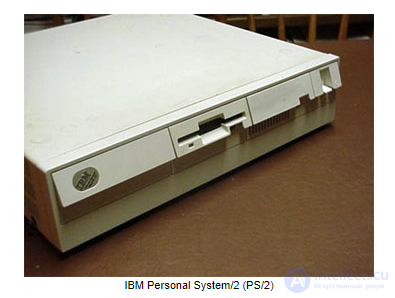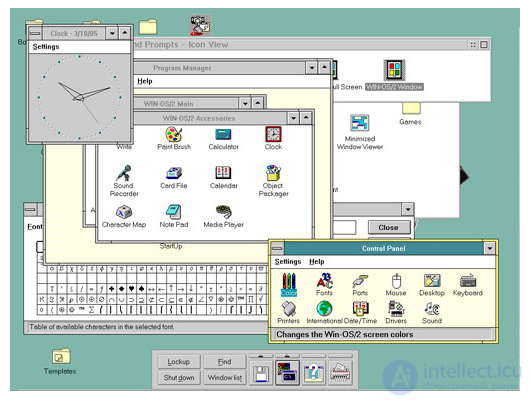Lecture
Ibm Personal System / 2
Until now, many of us use keyboards and even sometimes PS / 2 mice. However, not everyone knows where he came from and how this abbreviation stands for. The PS / 2 is Personal System / 2, a computer introduced by IBM in 1987. He belonged to the third generation of personal computers of the blue giant, whose purpose was to regain lost ground in the PC market.
IBM PS / 2 has failed. It was assumed that its sales would be high, but the system was very innovative and closed, which automatically raised its final cost. Consumers preferred the more affordable IBM PC clones. However, the PS / 2 architecture has left a lot behind.
The primary PS / 2 operating system was IBM OS / 2. For her, the new PCs were equipped with two BIOSes at once: ABIOS (Advanced BIOS) and CBIOS (Compatible BIOS). The first was needed for OS / 2 boot, and the second was for backward compatibility with IBM PC / XT / AT software. However, for the first few months, PS / 2 came with PC-DOS. Later, as an option, you could install Windows and AIX (one of the Unix variants).
IBM Personal System / 2 (PS / 2)

Together with PS / 2, a new bus standard was introduced to expand the functionality of computers - MCA (Micro Channel Architecture). She had to replace the ISA. In terms of speed, the MCA corresponded to the PCI presented a few years later. In addition, it had many interesting innovations, in particular, it supported the ability to exchange data directly between expansion cards, or simultaneously between multiple cards and the processor via a separate channel. All this later found use in the PCI-X server bus. MCA itself did not receive distribution due to the refusal of IBM to license it, so that clones would not appear again. In addition, the new interface was not compatible with ISA.
At that time, a DIN connector was used for connecting the keyboard, and a COM for the mouse. The new IBM personal computers offered to replace them with more compact PS / 2. Today, these connectors are already disappearing from modern motherboards, but then they were also available only by IBM. Only a few years later, they "went to the masses." The point here is not only the closeness of the technology, but also the need to refine the BIOS in order to fully support this interface.
PS / 2 made an important contribution to the video card market. Until 1987, there were several types of monitor connectors. Often they had many contacts, whose number was equal to the number of displayed colors. IBM decided to replace them all with one universal D-SUB connector. Information about the depth of red, green and blue was transmitted through it, bringing the number of displayed shades to 16.7 million. In addition, it has become easier for software to work with one type of connector than to support several.
Another new IBM is a video card with a built-in frame buffer (VideoGraphics Array or VGA), which today is called a video card memory. Then its volume in PS / 2 was 256 KB. This was enough for a resolution of 640x480 with 16 colors, or 320x200 and 256 colors. New video cards worked with the MCA interface, so they were only available for PS / 2 computers. Nevertheless, the VGA standard eventually became widespread.
OS / 2 Screenshot

Instead of large and not the most reliable 5.25-inch floppy disks, IBM decided to use 3.5-inch drives. The company was the first to start using them as the main standard. The main novelty of new computers has become twice the capacity of floppy disks - up to 1.44 MB. And by PS / 2 sunset, it doubled to 2.88 MB. By the way, there was one rather serious mistake in PS / 2 drives. They could not distinguish a 720 KB floppy disk from a 1.44 MB floppy disk. Thus it was possible to format the first as the second. In principle, it worked, but it ran the risk of data loss, and after such an operation only another PS / 2 computer could read the information from a floppy disk.
And another new PS / 2 is 72-pin SIMM RAM modules instead of outdated SIPPs. After a few years, they became the standard for all personal and not-so computers, until they were replaced by DIMM strips.
So, we have come to the end of the 80s. In these 10 years, IBM has done much more for the average consumer than in all those that have gone before this year. Thanks to her personal computers, we can now independently assemble our computer, and not buy the finished one as Apple would like. Nothing prevents us from installing any operating system on it except Mac OS, which is again available only to owners of Apple computers. We got freedom, and IBM lost the market, but earned fame as a pioneer.
By the early 1990s, the blue giant was no longer the dominant player in the computer world. Intel then rules in the processor market, Microsoft has become a leader in the segment of application software, Novell has succeeded in networks, Hewlett-Packard in printers. Even hard drives invented by IBM began to be produced by other companies, with the result that Seagate was able to come out on top (as early as the late 80s and holds this championship to this day).
In the corporate sector, not everything went wrong. Invented by IBM employee Edgar Codd in 1970, the concept of relational databases (if briefly, this is a way to display data in the form of two-dimensional tables) in the early 80s began to gain wide popularity. IBM even participated in the creation of the SQL query language. And here the payment for works - number one in the field of a DBMS by the beginning of the 90th became the Oracle.
Well, in the market of personal computers, Compaq pressed it, and eventually Dell. As a result, IBM President John Akers began the process of reorganizing the company, dividing it into autonomous units, each of which was in one particular area. Thus, he wanted to increase production efficiency and reduce costs. It is in this form that IBM met the last decade of the 20th century.
Comments
To leave a comment
History of computer technology and IT technology
Terms: History of computer technology and IT technology